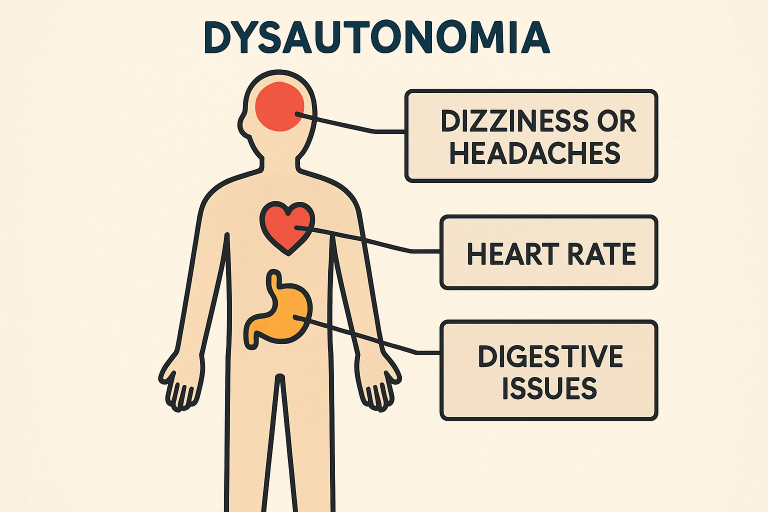Understanding Dysautonomia
Dysautonomia refers to a group of conditions that disrupt the autonomic nervous system (ANS), affecting involuntary bodily functions such as heart rate, blood pressure, digestion, and temperature regulation. Symptoms are variable and can significantly affect daily life, complicating diagnosis due to overlap with other chronic conditions. Common symptoms include dizziness, chronic fatigue, irregular heartbeats, digestive issues, temperature regulation problems, headaches, and sleep disturbances. Effective management often requires specialized care, as patients can remain undiagnosed for years, hindering treatment implementation.
Diagnosis Challenges
The diagnosis of dysautonomia is challenging due to its diverse symptoms and overlap with other health conditions. Patients often face lengthy journeys involving multiple specialists and extensive testing before achieving a correct diagnosis. Clinical evaluations typically include meticulous symptom documentation, physical examinations, monitoring of heart rate and blood pressure (such as tilt table testing), and neurological assessments to rule out other potential causes. Working with experienced dysautonomia specialists can help streamline this process, ensuring that patients receive accurate evaluations and tailored treatment plans. Accurate tracking of symptoms and effective communication with healthcare providers are essential for an accurate diagnosis.

Self-Management Strategies
While there is no universal cure for dysautonomia, adopting a structured self-management approach can alleviate symptoms and improve daily life. Lifestyle adjustments, symptom tracking, and consistent communication with healthcare teams form the backbone of an effective management plan.
Dietary Considerations
Hydration and electrolyte balance are key in managing dysautonomia. People are encouraged to increase fluids and electrolyte-rich drinks. For many, modest sodium intake helps maintain blood volume and reduce dizziness or fainting episodes. Monitoring caffeine and alcohol intake is important, as they can worsen dehydration and symptoms. Nutrition should be personalized based on symptoms and coexisting conditions. A dietitian with autonomic disorder can help customize nutrition plans, focusing on sodium, potassium, and other nutrients.
Exercise and Physical Activity
Physical activity is beneficial but should be tailored to individual tolerance. Gentle exercises, such as swimming, recumbent biking, or yoga, are recommended to reduce the risks associated with standing or overexertion. Regular exercise enhances blood flow, improves heart health, and boosts stamina. Working with a dysautonomia-aware therapist is key to a safe routine. Short, frequent movements can be more sustainable than sporadic, intense workouts.
Stress Management Techniques
Mental stress often amplifies dysautonomia symptoms, highlighting the importance of incorporating stress-reduction strategies into daily life. Mindfulness practices, deep breathing exercises, meditation, and gentle yoga can regulate the nervous system and moderate symptom flare-ups. Many people find that creating a predictable daily schedule helps reduce anxiety and keeps stress levels manageable.
Practical Lifestyle Adjustments
Making intentional changes to daily habits can ease symptom management. Compression garments, like socks, improve circulation, reduce blood pooling, and lower the risk. Elevating the head of the bed helps support blood pressure overnight. Other tips include rising slowly, avoiding hot environments, and refraining from standing for extended periods. These lifestyle tweaks help patients regain control and improve comfort and quality of life over time.
Conclusion
Successfully managing dysautonomia is a multifaceted process grounded in understanding, proactive self-management, and ongoing collaboration with knowledgeable healthcare providers. By focusing on hydration, balanced nutrition, regular yet gentle exercise, stress reduction, and practical lifestyle adjustments, individuals living with dysautonomia can gain confidence and enhance their overall well-being. Small, sustainable steps make a significant difference on the journey to an improved quality of life.
